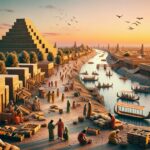Unveiling the Cradle of Civilization
Ancient Mesopotamia, often referred to as the “Cradle of Civilization,” holds a significant place in human history. Located between the Tigris and Euphrates rivers, primarily within modern-day Iraq, but also encompassing parts of Kuwait, Syria, Turkey, and even Iran, this region witnessed the birth of agriculture, urbanization, writing, and complex social structures. Its frequent appearance in the New York Times crossword puzzle, often clued as “region of ancient Mesopotamia,” speaks to its enduring importance. This article delves deeper than the crossword clue, exploring the wonders and complexities of this ancient world. Discover the breathtaking landscapes of the Potash Road Dinosaur Tracks and Petroglyphs, where ancient history and natural beauty converge.
A Land Between Rivers: Geographical and Historical Context
The term “Mesopotamia” originates from ancient Greek, meaning “between the rivers.” These rivers, the Tigris and Euphrates, were the lifeblood of the region, providing water for irrigation, transportation, and trade. The Fertile Crescent, a larger geographical area encompassing Mesopotamia, provided fertile land ideal for agriculture, which contributed significantly to the rise of early civilizations. The exact boundaries of ancient Mesopotamia were fluid, shifting with the rise and fall of empires and the natural course of the rivers. This dynamic geography impacted the political landscape and cultural interactions within the region.
The Rise and Fall of Empires: A Timeline of Mesopotamian Civilizations
Mesopotamia witnessed a succession of powerful empires and civilizations. Each contributed uniquely to the region’s rich history, leaving behind a legacy of innovation and cultural development. While the NYT crossword often points to Sumer as the “region of ancient Mesopotamia,” the answer can vary depending on the context of the clue. It’s important to remember the broader scope of Mesopotamian history, which includes other significant civilizations like Akkad, Babylon, and Assyria.
| Time Period | Civilization/Empire | Key Features/Achievements |
|---|---|---|
| c. 7500 BCE | Jarmo (early agricultural settlement) | Development of early farming techniques |
| c. 6500-5500 BCE | Hassuna Culture | Development of pottery and village life |
| c. 6000-5000 BCE | Halaf Culture | Distinctive painted pottery styles |
| c. 5900-4000 BCE | Samarra Culture | Advanced irrigation techniques |
| c. 5000-4000 BCE | Ubaid Culture | Growth of large villages and early temple architecture |
| c. 4000-2000 BCE | Sumerian Civilization | Development of cuneiform writing, city-states, ziggurats |
| c. 2334-2154 BCE | Akkadian Empire | First Mesopotamian empire, unified city-states under Sargon of Akkad |
| c. 1894-1595 BCE | Old Babylonian Empire (including Hammurabi) | Hammurabi’s Code, advancements in mathematics and astronomy |
| c. 1595-1155 BCE | Kassite Dynasty | Relatively stable period, introduction of the horse and chariot |
| c. 911-609 BCE | Neo-Assyrian Empire | Powerful military, vast empire, elaborate palaces and libraries |
| c. 626-539 BCE | Neo-Babylonian Empire | Hanging Gardens of Babylon (one of the Seven Wonders of the Ancient World), revival of Babylonian culture |
| c. 539-331 BCE | Achaemenid Empire (Persian) | Extensive empire, administrative organization, tolerance of conquered peoples |
Innovations and Achievements: Shaping the Course of History
Ancient Mesopotamia was a hub of innovation, contributing significantly to the development of human civilization. These advancements laid the foundation for many aspects of modern society, demonstrating the ingenuity and resourcefulness of the Mesopotamian people.
- Cuneiform Writing: This groundbreaking invention, developed by the Sumerians, was the earliest known form of writing. It allowed for record-keeping, administrative organization, and the development of literature, transforming communication and knowledge transmission.
- Irrigation Systems: The development of sophisticated irrigation systems enabled intensive agriculture in the arid Mesopotamian environment. These canals and ditches controlled the flow of water from the Tigris and Euphrates, supporting larger populations and contributing to the growth of cities.
- The Wheel: While its exact origin is debated, the wheel emerged in Mesopotamia and revolutionized transportation and agriculture.
- Mathematics and Astronomy: Mesopotamians made significant advancements in mathematics, including the development of a base-60 system that still influences how we measure time and angles today. Their observations of the night sky laid the groundwork for astronomy.
- Law Codes: Hammurabi’s Code, one of the earliest examples of written law, provides insights into the legal and social structures of ancient Babylon.
- Architecture: The construction of monumental buildings, such as ziggurats – stepped religious structures – showcases the architectural and engineering skills of the Mesopotamians.
Life in Ancient Mesopotamia: Society, Culture, and Challenges
Daily life in ancient Mesopotamia varied greatly depending on social class, occupation, and the specific time period. While rulers and elites enjoyed relative luxury, farmers, laborers, and slaves faced challenging conditions. Religion played a central role in Mesopotamian society, with a pantheon of gods and goddesses influencing various aspects of life. The Epic of Gilgamesh, a Mesopotamian literary masterpiece, provides glimpses into the culture, beliefs, and values of the time. Environmental challenges, such as increasing soil salinity due to irrigation and deforestation, posed constant threats to the region’s prosperity.
Mesopotamia’s Enduring Legacy
While the great empires of ancient Mesopotamia eventually declined and fell, their influence on later civilizations is undeniable. Their innovations in writing, law, mathematics, and astronomy spread throughout the ancient world, shaping the course of history. Ongoing archaeological research continues to unearth new discoveries about this fascinating region, further illuminating our understanding of its people, culture, and lasting contributions to humanity. The next time you encounter “region of ancient Mesopotamia” in the NYT crossword, you’ll appreciate the depth and complexity behind the clue, recognizing it as a gateway to a world of ancient wonders.
- Unlock Filipino Culture: A Deep Dive into Traditions and Practices - April 23, 2025
- Unlock Spanish Culture: Insights & Opportunities Now - April 23, 2025
- White Spirit Uses & Substitutes: A Deep Dive for Pros & DIYers - April 23, 2025
















